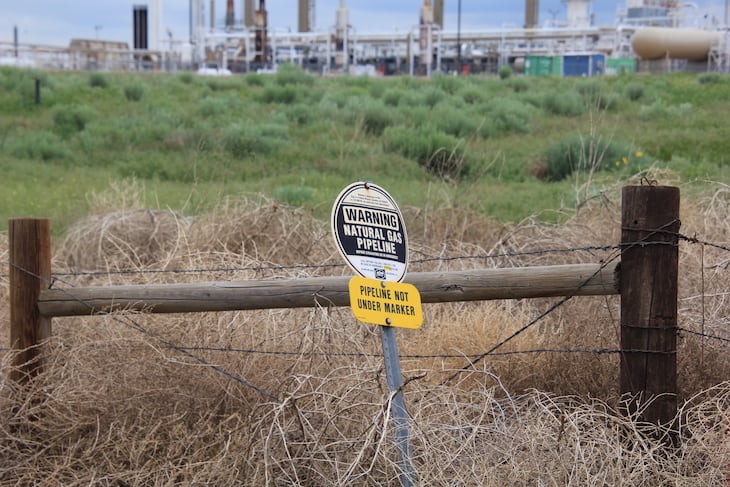That’s the question before state regulators and consumers. Will today’s high-cost fixes become stranded assets in 15 years?
by Allen Best
Fifteen years can make a huge difference. I vividly remember attending the annual meeting of the Delta-Montrose Electric Association in 2008. An extravagance of red, white, and blue bunting disguised the loading dock of the electrical cooperative where directors of Delta-Montrose sat. They were staking out a new definition of patriotism.
Their wholesale supplier, Tri-State Generation & Transmission, wanted to build a giant coal plant in Kansas to meet escalating electrical demand. Tri-State asked its 44 member cooperatives in Colorado and three adjoining states to extend their all-requirements contracts to 2050. Delta-Montrose and a cooperative based in Taos, N.M., balked.
The keynote speaker, the chief executive of a state trade organization closely aligned with Tri-State, reprimanded Delta-Montrose. Coal, he insisted, was the answer then—and far into the future.
The facts seemed to be on his side. Coal extraction reached a new peak in 2008. It was cheap and plentiful. Natural gas prices, though, had reached stratospheric levels. The marvels of hydraulic fracturing had not yet produced the bounty of hydrocarbons. As for wind and solar, their prices were declining, but they generally remained more expensive.
Xcel Energy and its two partners – Holy Cross Energy and another cooperative now called CORE – also saw coal as the future. In Pueblo, they were building a new plant, Comanche 3.
Fifteen years later, the landscape looks entirely different. Last week, Tri-State, Colorado’s second largest electrical utility announced it wants to accelerate the closing of its final coal-burning unit at Craig to 2028, two years earlier than previously scheduled. It will also close a newish coal plant in Arizona by 2031. These plans depend upon whether Tri-State can get federal aid earmarked by the Inflation Reduction Act for retiring stranded assets.
As for that coal plant in Pueblo, it’s to close by 2031, possibly earlier. Original date: 2070.
Good thing Tri-State failed to build that giant coal plant in Kansas in 2008. Extraction of coal in the United States peaked that year. Coal was king. Look at it now.
Now, as they plan their systems 15 years into the future, Xcel Energy and Tri-State, the state’s two largest electrical utilities, both want to build natural gas plants as they close coal plants. Fort Collins-based Platte River Power Authority, the state’s fourth largest utility, hasn’t formally proposed natural gas. However, directors from the four northern Colorado municipal utilities have given managers authority to begin the permitting process.
The utilities must meet peak demands when renewables come up short. One such time came in February 2021. Winds ceased blowing for several days. Solar production was thin. Tri-State resorted to burning oil to create electricity.
Our hot days of summer will likely get hotter yet. Colorado this year was cool, but still new heat records were set or tied in Alamosa, Grand Junction, and elsewhere. We can expect increased heat. If unlikely, it’s still possible that the Front Range cities could have a few unprecedented days of 108 to 110 degrees—or even hotter. Air conditioners would go crazy.
Finally, while demand has flattened in recent years, the result of improved energy efficiency, utilities expect sharp increases as we try to electrify most everything. Transportation will happen most easily, but buildings will take time.
Natural gas has been called the bridge to decarbonization. How far out do we need this bridge? Even the utility managers that I consider rock stars of the energy transition differ. Mark Gabriel, CEO of United Power, the 110,000-member cooperative north of Denver, insists we’ll need some small amounts of natural gas to mid-century. At Holy Cross Energy, the cooperative serving the Vail and Aspen areas, Bryan Hannegan is stretching to achieve emissions-free electricity by 2030. That sounds like no natural gas.
A study commissioned by the Colorado Energy Office also sees a small role for natural gas, about 1.5% in 2040. For 100% emissions-free electricity, the costs escalate.
Might a new technology arrive? A game-changer would be long-duration and affordable storage such as that which could hoard surplus wind generation for 100 hours or more. Working with Form Energy, Xcel Energy will test one such technology in Pueblo in 2024. Or could smaller solutions broadly distributed be the answer?
Colorado regulators on Wednesday began talking about Xcel’s plans. Megan Gilman, a public utilities commissioner from Edwards, and Tom Plant, a commissioner from Buena Vista, both identified the problem of leaving electric customers on the hook for the costs of building natural gas plants if they become stranded by new technology.
Another way of saying this is that nobody has all the answers. Just keep in mind that just 15 years ago coal was king.
Long-time journalist Allen Best covers Colorado’s transitions in energy and water at bigpivots.com, Subscriptions are free.
Why support Big Pivots?
You need and value solid climate change reporting, and also the energy & water transitions in Colorado. Because you know that strong research underlies solid journalism, and research times take.
Plus, you want to help small media, and Big Pivots is a 501(c)3 non-profit.
Big grants would be great, but they’re rare for small media. To survive, Big Pivots needs your support. Think about how big pivots occur. They start at the grassroots. That’s why you should support Big Pivots. Because Big Pivots has influence in Colorado, and Colorado matters in the national conversation.
- How much water remains in southeast Colorado’s aquifers? - April 18, 2024
- Keeping water rights on the Yampa while utilities figure out future technologies - April 18, 2024
- How can Colorado add this much renewable energy by 2040? - April 18, 2024






There are two crucial differences between coal and natural gas powerplants in a grid with large amounts of VRE (variable renewable electricity).
First, big advantage gas, is that new gas plants (particularly simple turbines) start, ramp and stop much more quickly, so they can just back up VRE only when needed. With a modest amount of batteries, even less idling or spinning reserve is needed. Coal plants take days to start. That’s why we curtail renewables even while burning fossil fuels.
Second, disadvantage gas, is that gas fuel is dependent on a pipeline network which has its own costs even when idle and may or may not be available at a reasonable price when needed. Those big piles of coal beside the powerplants are great energy storage and inventory.
Strangely, expensive “oil” in the form of ultra-low sulfur diesel is not a bad backup fuel for turbines at very low load factors. It can be stored on site, and the generator doesn’t need to pay to maintain pipeline capacity for a year, when it’s only needed for 100 hours.